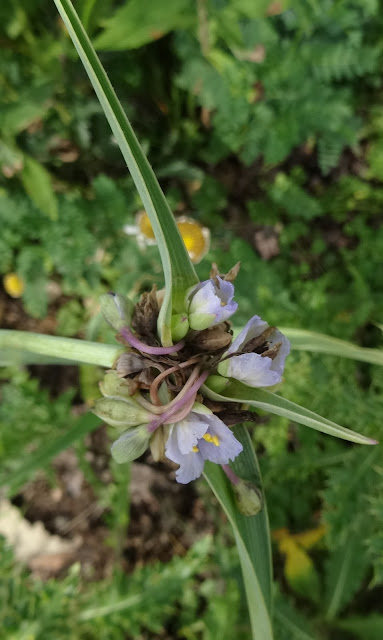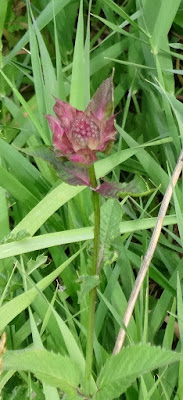8/29/2023
8/08/2023
7/09/2023
spiderwort
Critters have been eating plants and leaving evidence behind . . . broken off flower stalks, chewed reeds, left-behind stems, grass sheared off at ground level.
The muskrats swim across the pond to gather food on the opposite shores. The rabbits browse among the plants around the pond. I wonder who ate the Spiderwort?
7/04/2023
smooth oxeye
7/03/2023
bergamot
5/20/2023
5/17/2023
prairie smoke
4/30/2023
yellow loosestrife
 |
| Daffodil (left) besides young Lysimachia leaves |
Lowland Yellow Loosestrife Lysimachia hybdrida, a perennial native plant, is sprouting again near the pond. The stems will to grow to 30-40 inches tall, then flowers will appear in June. Some specialist bees will gather the oils that the flower produces to mix with pollen as food for its offspring.
pasque flowers
4/02/2023
blizzard and frost depth
Because so much insulating snow came down early in November and piled up repeatedly throughout winter . . . soil frost depth is minimal at this time. With all the moisture in the ground, it should be a good year for wildflowers!
10/03/2022
canada milkvetch
Seed pods of Canada Milkvetch are beginning to dry enough to spill the tiny seeds. In the background is the ubiquitous white asters that grow everywhere among native wildflowers at this time of the year.
9/18/2022
8/19/2022
8/15/2022
August wildflowers
8/07/2022
8/02/2022
summer native bloomers
Blossoming among the grasses and rushes around the pond are Blue Vervain, Culvers Root, Wild Bergamot, Evening Primrose. Seed heads of Penstemon stand as they dry in the sun.
7/22/2022
vervain
7/15/2022
monardas - bee balm - bergamot
6/17/2022
6/12/2022
smooth penstemon
Foxglove Beardtongue, Penstemon digitalis (also called Smooth Penstemon) has white flowers that bloom for a month or longer.
The tubular flowers attract long-tongued bees such as bumblebees and mason bees, as well as hummingbirds. This is one of the plants we are trying to encourage in the riparian area around the pond.
Good for pollinators!
























